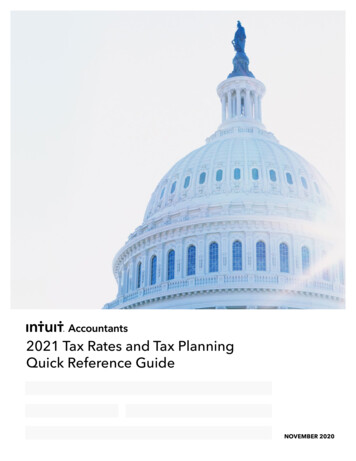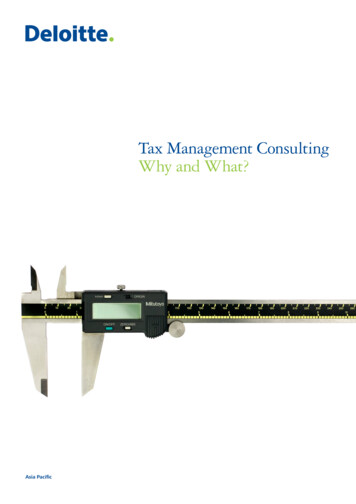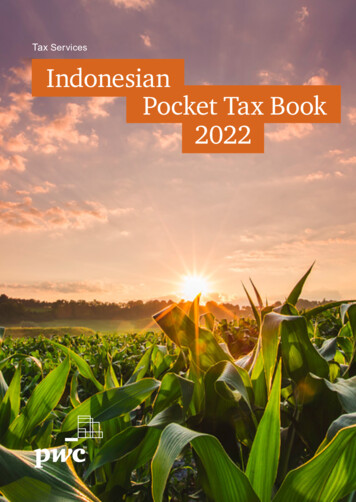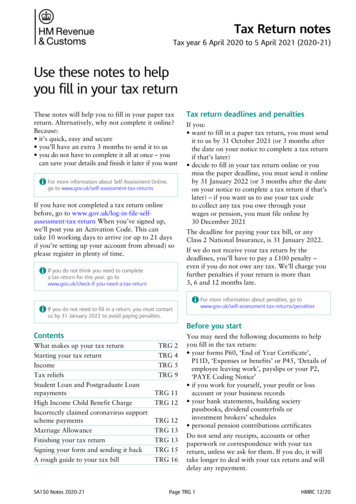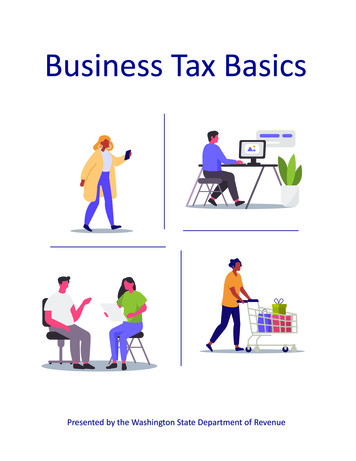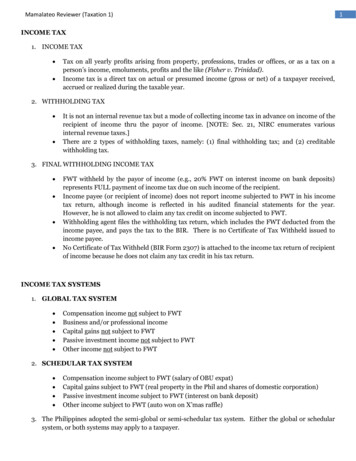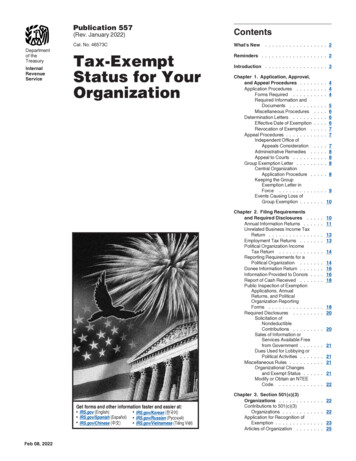
Transcription
Departmentof theTreasuryInternalRevenueServicePublication 557(Rev. January 2022)ContentsCat. No. 46573CWhat's NewTax-ExemptStatus for YourOrganizationReminders . . . . . . . . . . . . . . . . . . . 2. 2Introduction . . . . . . . . . . . . . . . . . . 3Chapter 1. Application, Approval,and Appeal Procedures . . . .Application Procedures . . . . .Forms Required . . . . . .Required Information andDocuments . . . . . . .Miscellaneous ProceduresDetermination Letters . . . . . .Effective Date of ExemptionRevocation of Exemption .Appeal Procedures . . . . . . . .Independent Office ofAppeals ConsiderationAdministrative Remedies .Appeal to Courts . . . . . .Group Exemption Letter . . . . .Central OrganizationApplication Procedure .Keeping the GroupExemption Letter inForce . . . . . . . . . .Events Causing Loss ofGroup Exemption . . . .Chapter 2. Filing Requirementsand Required Disclosures . .Annual Information Returns . . .Unrelated Business Income TaxReturn . . . . . . . . . . . . .Employment Tax Returns . . . .Political Organization IncomeTax Return . . . . . . . . . .Reporting Requirements for aPolitical Organization . . . .Donee Information Return . . . .Information Provided to Donors .Report of Cash Received . . . .Public Inspection of ExemptionApplications, AnnualReturns, and PoliticalOrganization ReportingForms . . . . . . . . . . . . .Required Disclosures . . . . . .Solicitation ofNondeductibleContributions . . . . . .Sales of Information orServices Available Freefrom Government . . . .Dues Used for Lobbying orPolitical Activities . . . .Miscellaneous Rules . . . . . . .Organizational Changesand Exempt Status . . .Modify or Obtain an NTEECode. . . . . . . . . . .Get forms and other information faster and easier at: IRS.gov (English) IRS.gov/Spanish (Español) IRS.gov/Chinese (中文)Feb 08, 2022 IRS.gov/Korean (한국어) IRS.gov/Russian (Pусский) IRS.gov/Vietnamese (Tiếng Việt)Chapter 3. Section 501(c)(3)Organizations . . . . . . . .Contributions to 501(c)(3)Organizations . . . . . . .Application for Recognition ofExemption . . . . . . . . .Articles of Organization . . . 4. 4. 4.566677.7888. 8. 9. . . 10. . . 10. . . 11. . . 13. . . 13. . . 14.14161618. . . 18. . . 20. . . 20. . . 21. . . 21. . . 21. . . 21. . . 22. . . . . 22. . . . . 22. . . . . 23. . . . . 25
Educational Organizations andPrivate Schools . . . . . . .Organizations ProvidingInsurance . . . . . . . . . .Other Section 501(c)(3)Organizations . . . . . . . .Private Foundations and PublicCharities . . . . . . . . . . .Lobbying Expenditures . . . . . . . 26. . . . 28. . . . 28. . . . 30. . . . 46Chapter 4. Other Section 501(c)Organizations . . . . . . . . . .501(c)(4) - Civic Leagues andSocial Welfare Organizations501(c)(5) - Labor, Agriculturaland HorticulturalOrganizations . . . . . . . . .501(c)(6) - Business Leagues,etc. . . . . . . . . . . . . . . .501(c)(7) - Social andRecreation Clubs . . . . . . .501(c)(8) and 501(c)(10) Fraternal BeneficiarySocieties and DomesticFraternal Societies . . . . . .501(c)(4), 501(c)(9), and 501(c)(17) - Employees'Associations . . . . . . . . .501(c)(12) - Local BenevolentLife Insurance Associations,Mutual Irrigation andTelephone Companies, andLike Organizations . . . . . .501(c)(13) - CemeteryCompanies . . . . . . . . . .501(c)(14) - Credit Unions andOther Mutual FinancialOrganizations . . . . . . . . .501(c)(19) - Veterans'Organizations . . . . . . . . .501(c)(21) - Black Lung BenefitTrusts . . . . . . . . . . . . .501(c)(2) - Title-HoldingCorporations for SingleParent Corporations . . . . .501(c)(25) - Title-HoldingCorporations or Trusts forMultiple Parent Corporations501(c)(26) - State-SponsoredHigh-Risk Health CoverageOrganizations . . . . . . . . .501(c)(27) - QualifiedState-Sponsored Workers'Compensation Organizations501(c)(29) - CO-OP HealthInsurance Issuers . . . . . .Chapter 5. Excise Taxes . . . . .Prohibited Tax ShelterTransactions . . . . . . . .Excess Benefit Transactions .Excess Business Holdings . .Taxable Distributions ofSponsoring Organizations .Taxes on Prohibited BenefitsResulting from DonorAdvised Fund DistributionsExcise Taxes on PrivateFoundations . . . . . . . . .Excise Taxes on Black LungBenefit Trusts . . . . . . . .Excise Tax on Failure to Meetthe Community HealthNeeds AssessmentRequirements . . . . . . .Page 2. . . 48Excise Tax on ExecutiveCompensation . . . . . . . . . . . 66Excise Tax on Net InvestmentIncome of Certain Collegesand Universities . . . . . . . . . . 66Chapter 6. How to Get Tax HelpOrganization Reference Chart . . . . . . 69Appendix. Sample Articles ofOrganization . . . . . . . . . . . . . . 70. . . 48Appendix. Sample Articles ofOrganization, continued. . . 49Index. . . 49. . . 50. . . 51. . . 52. . . 54. . . 55. . . 56. . . 56. . . 57. . . 58. . . 58. . . 59. . . 59. . . 59. . . . 60. . . . 60. . . . 60. . . . 64. . . . 64. . . . 65. . . . 65. . . . 65. . . . 66. . . . 66. . . . . . 72. . . . . . . . . . . . . . . . . . . . . 75What's NewFuture developments. The IRS has created apage on IRS.gov for information about Publication 557, at IRS.gov/pub557. Information aboutany future developments affecting Publication557 (such as legislation enacted after we release it) will be posted on that page.Electronic Form 1024. As of January 3, 2022,Form 1024, Application for Recognition of Exemption Under Section 501(a) or Section 521,is available for electronic filing on Pay.gov. Aspart of the revision, applications for recognitionof exemption under Sections 501(c)(11), (14),(16), (18), (21), (22), (23), (26), (27), (28), (29,)and 501(d) can no longer be submitted as letterapplications. Instead, these requests must bemade on the electronic Form 1024. The IRS willprovide a 90-day grace period during which itwill continue to accept paper versions of Form1024 (Rev. 01-2018) and letter applications;however, after April 4 the Form 1024 must besubmitted electronically. See Rev. Proc.2022-8.Also, organizations requesting determinations under Section 521 are now able to use theelectronic Form 1024 instead of Form 1028, Application for Recognition of Exemption UnderSection 521.Update on mandatory e-filing. The TaxpayerFirst Act, enacted July 1, 2019, requires tax-exempt organizations to electronically file information returns and related forms. The new law affects tax-exempt organizations in tax yearsbeginning after July 1, 2019. Forms 990-T & 4720 are available fore-filing in 2022. In 2020, the IRS continued to accept paper Form 990-T, ExemptOrganization Business Income Tax Return,and Form 4720, Return of Certain ExciseTaxes Under Chapters 41 and 42 of the Internal Revenue Code, pending conversioninto electronic format. As described below,in 2021 the IRS announced e-filing is required for these forms as described below.For Form 990-T, any 2020, and any future year Form 990-T with a due date on orafter April 15, 2021, must be filed electronically and not on paper.For Form 4720, any 2020, and any future year, Form 4720 filed by a privatefoundation with a due date on or after July15, 2021, must be filed electronically andnot on paper. Organizations other than private foundations that are required to fileForm 4720 are encouraged, but not required, to file Form 4720 electronically. Forms 990, 990-EZ, & 990-PF e-filing.Form 990, Return of Organization ExemptFrom Income Tax, and Form 990-PF, Return of Private Foundation or Section4947(a)(1) Trust Treated as Private Foundation, for tax years ending July 31, 2020,and later MUST be filed electronically.Form 990-EZ, Short Form Return of Organizations Exempt from Income Tax, fortax years ending July 31, 2021, and laterMUST be filed electronically. The transitional relief applicable to the Form 990-EZunder which the IRS accepted either paperor electronic filing of Form 990-EZ appliedonly for tax years ending before July 31,2021.More information on software providersis available on the Exempt OrganizationsModernized e-File (MeF) Providers page.For more information, go to IRS:Recent legislation requires tax exemptorganizations to e-file forms.Section 501(c)(21) trusts. Form 990-BL, Information and Initial Excise Tax Return forBlack Lung Benefit Trusts and Certain RelatedPersons, will be a historical form beginning withtax year 2021. Section 501(c)(21) trusts can nolonger file Form 990-BL and will file Form 990(or submit Form 990-N, if eligible) to meet theirannual filing obligations under section 6033.Some section 501(c)(21) trusts may also be required to file Form 6069, Return of Certain Excise Taxes on Mine Operators, Black LungTrusts, and Other Persons Under Sections4951, 4952, and 4953.RemindersElectronic Form 1024-A. Form 1024-A, Application for Recognition of Exemption Under Section 501(c)(4), must be submitted electronicallyon Pay.gov.Reporting of donor information (Form 990,990-EZ, and 990-PF). Final regulations provide that the requirement to report contributornames and addresses on annual returns generally applies only to returns filed by Section501(c)(3) organizations and Section 527 political organizations. All tax-exempt organizationsmust continue to maintain the names and addresses of their substantial contributors in theirbooks and recordsIRS not accepting requests for group exemption numbers. The IRS will not acceptany requests for group exemption letters starting on June 17, 2020, until publication of the final revenue procedure or other guidance in theInternal Revenue Bulletin. See Notice 2020-36.Automatic revocation. Regarding automaticrevocation for the failure to file a return or noticefor 3 consecutive years, as required by section6033, the Taxpayer First Act of 2019, P.L.116-25, added a requirement that the IRS notifythe organization after the organization hasfailed to file for 2 consecutive years. See Automatic Revocation, later, for more information,including applicability dates.Publication 557 (January 2022)
Electronic Form 1023. Form 1023, Application for Recognition of Exemption under Section501(c)(3) of the Internal Revenue Code, isavailable only as an electronic form filed onPay.gov. Form 1023-EZ, Streamlined Application, is already on Pay.gov.Tax on investment income of private foundations. The Taxpayer Certainty and DisasterTax Relief Act of 2019, reduced the 2% excisetax on investment income of private foundationsto 1.39%. At the same time, the legislation repealed the 1% special rate that applied if theprivate foundation met certain distribution requirements. The change is effective for taxableyears beginning after December 20, 2019.Increase in UBTI for disallowed fringe repealed. The Taxpayer Certainty and DisasterTax Relief Act of 2019 retroactively repealed Internal Revenue Code (IRC) Section 512(a)(7),which increased unrelated business taxable income by amounts paid or incurred for qualifiedtransportation fringes. Congress had previouslyenacted this provision for amounts paid or incurred after December 31, 2017.Excise tax on executive compensation.Section 4960, added by Public Law 115-97, effective for tax years beginning after December17, 2017, imposes an excise tax on an organization that pays to any covered employee morethan 1 million in remuneration or pays an excess parachute payment during the year starting in 2018. See Excise Tax on Executive Compensation, chapter 5. See also section 4960and Form 4720, Return of Certain Excise TaxesUnder Chapters 41 and 42 of the Internal Revenue Code, for more information.Excise tax on net investment income of certain colleges and universities. Section 4968imposes an excise tax on the net investment income of certain private colleges and universities. See Excise Tax on Net Investment Incomeof Certain Colleges and Universities, chapter 5.See also section 4968 and Form 4720, Returnof Certain Excise Taxes Under Chapters 41 and42 of the Internal Revenue Code, for more information.Separate UBTI calculation for each trade orbusiness. Organizations with more than 1 unrelated trade or business must compute unrelated business taxable income (UBTI), includingfor purposes of determining any net operatingloss deduction, separately with respect to eachsuch trade or business. See Unrelated Business Income Tax Return, chapter 2. See alsoSchedule A (Form 990-T). The UBTI with respect to any such trade or business shall not beless than zero when computing total UBTI.Exception from the excise tax on excessbusiness holdings. Section 4943(g) createdan exception from the excise tax on excessbusiness holdings for certain independently operated enterprises whose voting stock is whollyowned by a private foundation. For more details, see Excess Business Holdings, chapter 5Organizational Changes. For tax years beginning on or after January 1, 2018, the IRS willno longer require a new exemption applicationfrom a domestic section 501(c) organizationthat undergoes certain changes of form or placeof organization, as described in Rev. Proc.2018-15, 2018-9 I.R.B. 379.Group Exemptions. Beginning January 2019,the IRS will no longer send the List of ParentPublication 557 (January 2022)and Subsidiary Accounts to the central organizations. See Group Exemption Letter, later.Form 8976. Each new section 501(c)(4) organization must notify the IRS of its intent to operate as a section 501(c)(4) organization regardless of whether it will seek recognition of itsexempt status under section 501(c)(4). UseForm 8976, Notice of Intent to Operate UnderSection 501(c)(4), to provide this notification.Form 8976 may only be completed and submitted electronically at: Electronically Submit YourForm 8976, Notice of Intent to Operate UnderSection 501(c)(4).Forms, Instructions and Publications. AllIRS forms, instructions and publications mentioned in this publication can be accessed onIRS.gov from the Forms and Instructions page.IntroductionThis publication discusses the rules and procedures for organizations that seek recognition ofexemption from federal income tax under section 501(a) of the Internal Revenue Code (theCode). It explains the procedures you must follow to obtain an appropriate determination letterrecognizing your organization's exemption, aswell as certain other information that appliesgenerally to all exempt organizations. To qualifyfor exemption under the Code, your organization must be organized for one or more of thepurposes specifically designated in the Code.Organizations that are exempt under section501(a) include those organizations described insection 501(c). Section 501(c) organizationsare covered in this publication.Chapter 1, Application, Approval, and Appeal Procedures, provides general informationabout the procedures for obtaining recognitionof tax-exempt status.Chapter 2, Filing Requirements and Required Disclosures, contains information aboutannual filing requirements and other mattersthat may affect your organization's tax-exemptstatus.Chapter 3, Section 501(c)(3) Organizations,contains detailed information on various mattersaffecting section 501(c)(3) organizations, including a section on the determination of privatefoundation status.Chapter 4, Other Section 501(c) Organizations, includes separate sections for specifictypes of organizations described in section501(c).Chapter 5, Excise Taxes, provides information on when excise taxes may be imposed.Chapter 6, How to Get Tax Help, providestips and resources on where to find answers totax questions or other assistance.Organizations not discussed in this publication. Certain organizations that may qualifyfor exemption aren't discussed in detail in thispublication, although they are included in theOrganization Reference Chart and the application procedures discussed in Chapter 1. Theseorganizations (and the Code sections that applyto them) are as follows:Corporations organized under Acts ofCongress . . . . . . . . . . . . . . . . . . . . . . .Teachers' retirement fund associations . . .Mutual insurance companies . . . . . . . . . .Corporations organized to finance cropoperations . . . . . . . . . . . . . . . . . . . . . .Employee funded pension trusts (createdbefore June 25, 1959) . . . . . . . . . . . . . .Withdrawal liability payment fund . . . . . . .Veterans' organizations (created before1880) . . . . . . . . . . . . . . . . . . . . . . . . . .National Railroad Retirement InvestmentTrust . . . . . . . . . . . . . . . . . . . . . . . . . .Religious and apostolic associations . . . .Cooperative hospital serviceorganizations . . . . . . . . . . . . . . . . . . . .Cooperative service organizations ofoperating educational organizations . . . . ction 501(c)(24) organizations (section4049 ERISA trusts) are neither discussed in thetext nor listed in the Organization ReferenceChart.Similarly, farmers' cooperative associationsthat qualify for exemption under section 521,qualified state tuition programs described insection 529, qualified ABLE programs described in section 529A, and pension, profit-sharing, and stock bonus plans described in section401(a) aren't discussed in this publication. VisitIRS.gov for more information on these types oforganizations. For telephone assistance, call 1–877–829–5500.Check the Table of Contents at the beginning of this publication to determine whetheryour organization is described in this publication. If it is, read the chapter (or section) that applies to your type of organization for the specificinformation you must give when applying forrecognition of exemption.Organization Reference Chart. The Organization Reference Chart enables you to locate ata glance the section of the Code under whichyour organization might qualify for exemption. Italso shows the required application form and, ifyour organization meets the exemption requirements, the annual return to be filed (if any), andwhether or not a contribution to your organization will be deductible by a donor. It also describes each type of qualifying organization andthe general nature of its activities.You may use the Organization ReferenceChart to identify the Code section that you thinkapplies to your organization. Any correspondence with the IRS (in requesting forms or otherwise) can be responded to faster if you indicatein your correspondence the appropriate Codesection. Check the IRS website, IRS.gov, forthe latest updates, Tax Information for Charities& Other Non-Profits, Tax Information forCharities & Other Non-Profits.Comments and suggestions. We welcomeyour comments about this publication and yoursuggestions for future editions.You can send us comments throughIRS.gov/FormComments. Or, you can write toInternal Revenue Service, Tax Forms and Publications, 1111 Constitution Ave. NW, IR-6526,Washington, DC 20224.Although we can’t respond individually toeach comment received, we do appreciate yourfeedback and will consider your comments asPage 3
we revise our tax forms, instructions, and publications. Don’t send tax questions, tax returns,or payments to the above address.Getting answers to your tax questions.If you have a tax question not answered by thispublication or How to Get Tax Help section atthe end of this publication, go to the IRS Interactive Tax Assistant page at IRS.gov/Help/ITAwhere you can find topics using the search feature or by viewing the categories listed.Getting tax forms, instructions, and publications. Visit IRS.gov/Forms to downloadcurrent and prior-year forms, instructions, andpublications.Ordering tax forms, instructions, andpublications. Go to IRS.gov/OrderForms toorder current forms, instructions, and publications; call 800-829-3676 to order prior-yearforms and instructions. The IRS will processyour order for forms and publications as soonas possible. Don’t resubmit requests you’ve already sent us. You can get forms and publications faster online.Application ProceduresOral requests for recognition of exemption won'tbe considered by the IRS. Your application forrecognition of tax-exempt status must be in writing using the appropriate forms as discussedbelow.If your organization is seeking recognition of exemption from federal income tax, it must use aspecific application prescribed by the IRS inRev. Proc. 2022-5, I.R.B 256, as amended byRev. Proc. 2022-8. If your organization is a central organization with exempt status, see GroupExemption Letter, later. All applications must besigned by an authorized individual.If your organization is one of the organizationsdescribed in this publication and is seeking recognition of tax-exempt status from the IRS, youshould follow the procedures described in thischapter and the instructions that accompanythe appropriate application forms.For information on section 501(c)(3) organizations, go to Section 501(c)(3) Organizations,chapter 3. If your organization is seeking exemption under one of the other paragraphs ofsection 501(c), see chapter 4.TopicsThis chapter discusses: Application procedures that generallyapply to all organizations discussed in thispublication, including the applicationforms; Determination letters (approvals/disapprovals); Appeal procedures available if an adversedetermination letter is proposed; and Group exemption letters.Page 4Chapter 1associations, 501(c)(10) Domestic fraternal societies, orders, etc., 501(c)(11) Teachers’ Retirement Fund Associations, 501(c)(12) Benevolent life insurance asso- Form 1023, Application for Recognition ofExemption Under Section 501(c)(3) of theInternal Revenue Code. File Form 1023 if youare seeking recognition of exemption undersection: 501(c)(3) Corporations, organized and op- Introductionorders, or associations, 501(c)(9) Voluntary employees’ beneficiaryForms Required1.Application,Approval, andAppealProcedures 501(c)(8) Fraternal beneficiary societies,erated exclusively for religious, charitable,scientific, testing for public safety, literary,or educational purposes, or to foster national or international amateur sports, orprevention of cruelty for children or animals, including the following types of organizations to which the specified subsections are applicable,501(e) Cooperative hospital service organization,501(f) Cooperative service organization ofoperating educational organizations,501(k) Certain organizations providingchild care,501(n) Charitable risk pools,501(q) Credit counseling organizations,and501(r) Hospital organizations.Applications for exempt status on a Form1023 must be electronically submitted throughPay.gov. See Rev. Proc. 2022-5.Form 1023-EZ, Streamlined Application forRecognition of Exemption Under Section501(c)(3) of the Internal Revenue Code.You may be eligible to file Form 1023-EZ if youare a smaller organization (assets of 250,000or less and annual gross receipts of 50,000 orless) seeking recognition of exemption undersection 501(c)(3). See Rev. Proc. 2022-5.Applications for exempt status on a Form1023-EZ must be electronically submittedthrough Pay.gov.Form 1024, Application for Recognition ofExemptions Under Section 501(a) or Section 521 of the Internal Revenue Code. FileForm 1024 if you are seeking recognition of exemption under section: 501(c)(2) Title holding corporations, 501(c)(5) Labor, agricultural, or horticultural organizations, 501(c)(6) Business leagues, chambers ofcommerce, etc., 501(c)(7) Social clubs,Application, Approval, and Appeal Procedures ciations, mutual ditch or irrigation companies, mutual or cooperative telephonecompanies,501(c)(13) Cemetery companies,501(c)(14) State-Chartered Credit Unions,Mutual Reserve Funds,501(c)(15) Mutual insurance companies orassociations,501(c)(16) Cooperative Organizations toFinance Crop Operations,501(c)(17) Trusts providing for the payment of supplemental unemployment compensation benefits,501(c)(18) Employee Funded PensionTrust (created before June 25, 1959,501(c)(19) A post, organization, auxiliaryunit, etc. of past or present members of theArmed Forces of the United States,501(c)(21) Black Lung Benefit Trusts,501(c)(22) Withdrawal Liability PaymentFund,501(c)(23) Veterans’ Organization (createdbefore 1880),501(c)(25) Title holding corporations ortrusts,501(c)(26) State-Sponsored OrganizationProviding Health Coverage for High-RiskIndividuals,501(c)(27) State-Sponsored Workers’Compensation Reinsurance Organization,501(c)(28) National Railroad RetirementInvestment Trust,501(c)(29) CO-OP health insurance issuers, and501(d) Religious and Apostolic Associations.Also, organizations requesting determinationsunder Section 521 are now able to use the electronic Form 1024 instead of Form 1028, Application for Recognition of Exemption Under Section 521 of the Internal Revenue CodeAs of January 3, 2022, applications for exempt status on a Form 1024 must be electronically submitted through Pay.gov. The IRS willprovide a 90-day grace period during which itwill continue to accept paper versions of Form1024 (Rev. 01-2018) and letter applications;however, after April 4, 2022 the Form 1024must be submitted electronically. See Rev Proc2022-5 as amended by Rev. Proc. 2022-8. Ifyou are filing Form 1024 on paper during thegrace period, you must also submit Form 8718with your application to submit the user fee.Form 1024-A, Application for Recognitionof Exemption Under Section 501(c)(4) ofthe Internal Revenue Code. File Form1024-A if you are seeking recognition of exemption under section 501(c)(4).Submitting Form 1024-A does not satisfy anorganization’s requirement to notify the Commissioner that it is operating under section501(c)(4), as required by section 506. SeeIRS.gov for information on satisfying the
notification requirement using Form 8976, Notice of Intent to Operate Under Section 501(c)(4).Form 1024-A, Application for Recognition ofExemption Under Section 501(c)(4), must befiled electronically on Pay.gov.Form 1028, Application for Recognition ofExemption Under Section 521 of the Internal Revenue Code. Use Form 1028, Application for Recognition of Exemption Under Section 521 of the Internal Revenue Code, if yourorganization is a farmers’ cooperative seekingrecognition of exemption under section 521.You must also submit Form 8718.Alternatively, organizations requesting determinations under Section 521 are now able touse the electronic Form 1024 instead of Form1028.Form 8871, Political Organization Notice ofSection 527 Status. Use Form 8871, PoliticalOrganization Notice of Section 527 Status, ifyou are a political organization seeking to betreated as tax-exempt under section 527 unlessan exception applies. See Political OrganizationIncome Tax Return, later.Some organizations don’t have to use specific application forms. The application your organization must use is specified in the chapterin this publication dealing with your kind of organization. It is also shown in the OrganizationReference Chart, later.Form 8871 must be filed at the IRS PoliticalOrganizations Filing and Disclosure site.Power of attorney. If your organization expects to be represented by an individual suchas an attorney, CPA, officer or other person authorized to practice before the IRS, whether inperson or by correspondence, you must file aForm 2848, Power of Attorney and Declarationof Representative, with your exemption application. The power of attorney must specifically authorize an individual to represent your organization. You can't name an organization, firm, etc.as your representative. Form 2848 can be usedfor this purpose. The categories of individualswho can represent you before the IRS are listedon the form.Form 8940, Request for Miscellaneous Determination. You can request miscellaneousdeterminations under sections 507, 509(a),4940, 4942, 4945, and 6033 using Form 8940.Nonexempt charitable trusts also file Form 8940for an initial determination of section 509(a)(3)status or change to their type. See Form 8940and instructions for more information.Requests other than applications.Requests other than applications forrecognition of exemption or Form 8940(for example, requests for letter rulings involving feeder organizations, application of excisetaxes to activities of private foundations, taxation of unrelated business income, etc.) shouldbe sent to the appropriate address listed in Rev.Proc. 2022-1, 2022-1 I.R.B. 1.These requests, similar to applications forrecognition of exemption previously discussed,must be accompanied by the appropriate userfee. The schedule for user fees, including thosefor requests other than applications, can befound in Rev. Proc. 2022-1.EO Determinations can request technicaladvice from the Office of Chief Counsel (EEE)on any question that can't be resolved on thebasis of law, regulations, or a clearly applicablerevenue ruling or other published precedent.See section 3, Rev. Proc. 2022-5.Reminder. The law requires payment of a userfee for determination letter requests. Go to Rev.Proc. 2022-5,Appendix A, to find the requiredpayment. Payment must accompany each request.Non-exemption for terrorist organizations.An organization that is identified or designatedas a terrorist organization within the meaning ofsection 501(p)(2) isn't eligible to apply for recognition of exemption.User fee. The law requires the payment of auser fee for determination letter requests suchas your application for recognition of tax-exempt status. User fees are listed in Rev. Proc.2022-5, Appendix A. If you are filing Form 1023,Form 1023-EZ, Form 1024 or 1024-A, the userfee must be submitted through Pay.gov.For the current user fee amount andTIP other information about applying fortax-exempt status go to IRS.gov andselect “Charities and Non-Profits” from the buttons near the top. Next, select “Applying forTax-Exempt Status” for more information. Youcan also call 1-877-829-5500.Required Information andDocumentsEmployer identification number (EIN). Every exempt organization must have its own EIN,whether or not it has any employees. An EIN isrequired before an exemption application issubmitted. I
Unrelated Business Income Tax Return. Employment Tax Returns. Political Organization Income Tax Return. Reporting Requirements for a Political Organization. Donee Information Return. Information Provided to Donors. Report of Cash Received. Public Inspection of Exemption Applications, Annual Returns, and Political Organization Reporting Forms .


